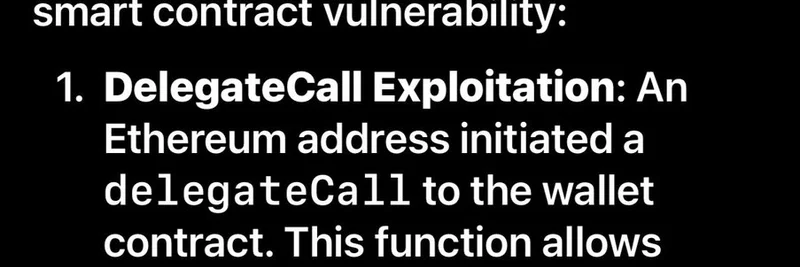The crypto world never sleeps, and neither do the hackers. Recently, the UXLINK project became the latest victim in a string of high-profile exploits, with a savvy attacker making off with around $28.1 million in ETH after compromising their multisig wallet. This incident, highlighted in a thread by crypto commentator MartyParty on X, underscores ongoing vulnerabilities in Ethereum smart contracts—issues that have plagued the space for years.
MartyParty, a well-known voice in crypto circles, pointed out this as yet another re-entrancy attack, though the specifics lean more toward a delegateCall exploitation. He's been warning about these Solidity pitfalls for ages, and this hack serves as a stark reminder. Let's break it down step by step, keeping things straightforward for anyone dipping their toes into blockchain tech.
What Happened in the UXLINK Hack?
According to on-chain analysis from Lookonchain, the hacker targeted UXLINK's multisig wallet—a setup designed for extra security by requiring multiple signatures for transactions. But the attacker bypassed this entirely. They received 490 million $UXLINK tokens and even minted an additional 2 billion more. From there, the tokens were dumped across decentralized exchanges (DEXes) via six different wallets, netting 6,732 ETH (worth about $28.1 million at the time). Additional sales happened on centralized exchanges (CEXes), flooding the market and tanking the token's price.
The hacker's addresses included:
- 0x78786A967ee948Aea1ccD3150f973Cf07d9864F3
- 0x9212f3a4528492622A02aF8bbc59A44c6c3c3539
- And several others listed in the original post.
This mass sell-off caused $UXLINK to plummet over 73% in just 24 hours, dropping to around $0.0877 with a market cap shrinking to $36.9 million.
How the Exploit Worked: A Deep Dive into DelegateCall
The core of this breach? A clever use of Ethereum's delegateCall function, which MartyParty detailed in an attached graphic. Multisig wallets are meant to be Fort Knox-level secure, but if the underlying smart contract has flaws, it's game over.
Here's the breakdown:
DelegateCall Exploitation: The attacker initiated a delegateCall to the wallet contract from an external Ethereum address. In simple terms, delegateCall lets one contract run code from another while keeping the context (like storage and balance) of the calling contract. It's often used in upgradable contracts or proxies, but if not implemented carefully, it can allow outsiders to hijack logic without owning the contract outright. Think of it as borrowing someone's car keys and reprogramming the engine mid-drive.
Admin Role Removal: Using this hijacked access, the delegateCall stripped away the existing admin roles from the contract. This essentially locked out the legitimate owners, giving the hacker free rein.
From there, though not fully detailed in the graphic, it's likely the attacker assigned themselves new admin privileges, enabling the massive token minting and transfers. This isn't your run-of-the-mill re-entrancy (where a contract calls back into itself before finishing an operation, like The DAO hack of 2016), but more of a proxy/logic injection vuln. Still, it highlights how old-school Solidity issues keep resurfacing in new projects.
On-Chain Evidence: Transactions and Dumps
Lookonchain's screenshots paint a clear picture of the aftermath. We see repeated Uniswap V4 executions where huge chunks of $UXLINK were swapped for ETH—batches of 15 million, 8 million, and more, raking in hundreds of ETH each time. Then, the funds were bridged or deposited to CEXes like Bitget, KuCoin, and Gate.io, with 10 million tokens outflowing to each in quick succession.
Why This Matters for Meme Tokens
While UXLINK isn't strictly a meme token—it's tied to a Web3 social platform—these exploits hit close to home for the meme coin crowd. Many meme projects launch on Ethereum with hastily audited (or unaudited) contracts, making them prime targets. DelegateCall risks are common in upgradable token standards, and one slip-up can lead to infinite mints or drained liquidity pools.
If you're building or investing in meme tokens, take notes:
- Audit Thoroughly: Use reputable firms and test for delegateCall, re-entrancy, and access control flaws.
- Multisig Best Practices: Don't expose admin functions without safeguards like time-locks.
- Stay Informed: Follow analysts like MartyParty or Lookonchain for real-time alerts.
This hack joins a long list of Ethereum woes, from Ronin to Poly Network. As MartyParty quipped, "just add it to the list." But with better education and tools, maybe we can shorten that list moving forward.
For the full thread and community reactions, check out the original post on X. What's your take—another wake-up call or just crypto business as usual? Drop your thoughts below.



